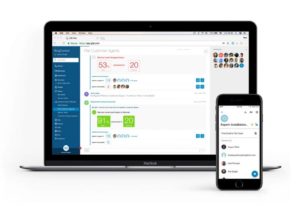All customers expect a seamless contact center experience. But it so rarely happens. They find themselves being passed from agent to agent, explaining the same situation over and over. It’s repetitive. It’s tedious. It’s a good enough reason to lose faith in any company and take their business elsewhere.
A fully optimized omnichannel cloud contact center connects everything; from live chats to social media, and SMS to your CRM system. Thus, creating a seamless customer experience and helping you achieve your KPIs.
The customer journey is one of the most important aspects of your business. An omnichannel cloud contact center ensures that you can communicate with customers easily and efficiently throughout. In our technologically advancing world, customers now expect an omnichannel cloud contact center experience that caters to their every need.
But what actually is it? Read on, and find out.
What is an omnichannel cloud contact center?
What is an omnichannel cloud contact center?
The benefits of omnichannel contact centers
How do you create an omnichannel strategy?
Omnichannel center solution software
FAQs
Provide excellent customer service with an Omnichannel approach
An omnichannel cloud contact center is a customer service function that allows customers to seamlessly switch back and forth across channels when seeking support. How? It uses hosted, cloud-based contact center software to handle customer interactions across multiple channels.
How do contact centers work?
Let’s back it up for a second. Before thinking about omnichannel, it’s important to understand how contact centers work.
The main goal of a contact center is to act as a bridge between the customer and the company. Most contact center agents have the following responsibilities, amongst others:
- Handling inbound and outbound calls
- Interviewing clients and verifying information
- Resolving customer complaints and providing general customer support
- Responding to emails or SMS
- Maintaining communication equipment by reporting problems
- Staffing live chat channels
- Social media support (on channels such as Twitter and Instagram)
Most contact centers work using VoIP software which combines interactive voice response (IVR), call screening, voicemail, predictive dialer, call recording, SMS, conference calling, and video calling to ensure top quality customer experiences and aid customer retention.
What does omnichannel mean?
So, what about omnichannel? Omnichannel is a cross-channel strategy that organizations use to streamline their services and create a better customer journey. Rather than merely working in parallel, communication channels and their supporting resources work together.
The omnichannel concept can operate across many different areas of business. While this article is focusing on contact centers, omnichannel is also regularly used in ecommerce and marketing. An omnichannel shopping experience allows shoppers to use different techniques for a streamlined experience.
Sephora, for example, uses omnichannel methods to connect the online and in-store shopping experience. By connecting to an app on their phone, a customer can get more when shopping in-store; gaining points, watching YouTube makeup tutorials, and finding products with ease. The two experiences work together to provide a better customer journey and ensure customer engagement.
Put simply, omnichannel means that every cog in the machine connects. It shouldn’t get mixed up with multichannel, which is the term for a number of different channels, which run on different systems and often remain siloed. Customer experiences are not shared across channels in multichannel.
What is omnichannel in contact center?
In a contact center, omnichannel allows customers seeking support to seamlessly switch back and forth across channels, whether that’s:
- Phone calls
- Video calls
- SMS
- Social media
- Live chat
- Mobile apps
- Self-service channels like FAQs or knowledge bases
Let’s say Shiv has ordered a new phone online, but it’s damaged. She’s called her network provider a few times and is calling again to resolve the issue. The software behind an omnichannel cloud contact center tracks her details and establishes that Shiv has called in several times already. The agent knows Shiv has an open case, saving her the need to repeat herself.
What if Shiv needs to show the damages? Using an omnichannel cloud contact center, the agent can switch from phone call to text, allowing Shiv to take a photo of the phone and send it over.
Hosted, cloud-based contact center software handles Shiv’s interactions across multiple touchpoints, ensuring that no data is left behind.

So, now that you know the meaning of omnichannel contact centers, how can they help you? What are the benefits?
Mapping the customer journey
Journey mapping is the process of creating a customer journey map: a visual story of your customers’ interactions with your brand. The exercise helps you step into a customer’s shoes and see your business from the customer’s perspective.
In a contact center, this means establishing how long it takes for a customer complaint or query to be resolved. You start from the very first call, and map the journey to the case being closed. An omnichannel contact center helps this process, because it keeps all customer data stored in one place. Making it easily accessible to map the journey.
Here’s some advice when customer journey mapping:
- Set a goal: You can’t map a journey without setting a goal. What do you want from this process? Improve customer satisfaction (CSAT) scores? Finding which technology is best for your customer care? Knowing the answers to these questions will give more purpose to your process.
- Do your research: Customer mapping relies on research. You need to drive the results you want. So, firstly gather as much data as possible about your customers. The end map shouldn’t have any biases; it should all be based on research and fact. This means that your results will be more tangible.
- Know your business: As a business owner, you need to know every element of your business. Don’t forget frontline staff like receptionists or admin workers alongside your contact center leaders. Interview your employees to establish any issues that should be factored into the map.
- Act as the customer: How can you learn about your customers? Try being them for a day. Go through the customer experience map, acting as a customer. This helps to find any missing elements before you get too far along the process.
- Measure it: Be sure to include KPIs or metrics at each step in the journey to help clarify performance gaps.
- Prioritize: It’s impossible to tackle everything at once. So, once you’ve completed the journey map, decide which pain points are the most important. From your list, you can create a productive and realistic roadmap that actually gets results.
Utilizing social media
Lots of business owners struggle to use social media properly. It’s only natural: social media is fairly new and we’re still learning how to use it to our advantage. It’s also a young person’s game, which means that more traditional business owners often shy away from using it at all.
However, an omnichannel contact center can hugely improve your connection with social media. By integrating your social media platforms, you track every customer journey and can see where they have previously contacted you. Whether that’s on Facebook Messenger, Instagram Live, or Twitter, many companies are now using live chat functions to connect to customers quicker than ever before.
Connecting social media with your phone and SMS communication simply creates a more seamless experience across the board.

Boosting customer experiences
The main aim of omnichannel cloud contact centers is to boost the customer experience. The contact center functions to communicate with your customers. So, it should communicate in the very best way.
Customers hate sitting on hold. It can be incredibly frustrating. However, if they’re able to communicate with you via chat, SMS, or social media, this eliminates waiting times. They also hate repeating their problem over and over again to different agents. When an omnichannel solution is in place, your customer service agents are more in the know and don’t need to ask repetitive and tedious questions.
All in all, this creates a better customer experience, creating more loyal customers.
Creating a global voice
Business continuity is key. An intelligent omnichannel cloud contact center creates the opportunity to create a global voice for your business. While every unified agent might naturally speak slightly differently, you can train your agents to use the same language across all digital channels and track whether there are any inconsistencies.
Speech analytics make your business more memorable and creates brand unity. Omnichannel contact centers also help with both workforce management and performance management.
How do you create an omnichannel strategy?
It’s important to note that an omnichannel strategy isn’t just investing in software. There are a number of steps you will need to take to integrate the omnichannel concept into your contact center.
What is an omnichannel strategy?
First things first, what actually is an omnichannel strategy? Put simply, it’s the steps you will take to implement omnichannel services and in doing so ensure the best customer experience.
Omnichannel strategy steps
Here are some of the key steps to an omnichannel strategy:
- Do your customer journey mapping. Your first step is to establish your core customer needs and understand what they want. Are they using social media and messaging apps regularly, for instance?
- Decide how many channels you want. Sure, all of them might seem cool, but it’s important to understand that customers might prefer it if you only offered a few and did them right. Establish your priorities. Do you want to get SMS right first before moving onto social media? Do you want to nail live chat before exploring automation via chatbots?
- Address internal barriers. You don’t want to implement omnichannel services if your contact center is struggling with other factors. Make sure everything is streamlined and working well before advancing.
- Balance automated and human engagement. An optimal omnichannel customer experience is all about understanding how to match customer expectations with the most effective response. Some responses can use chatbots, others can’t. Get it right.
Buy the software. Yes, it might not seem like it, but buying the software should be the final step when going omnichannel. Take the time to research the options and find the best software to empower your business. Don’t forget to assess your budget and ensure that costs are realistic.
Omnichannel center solution software

Image from RingCentral.com
Software is key to ensuring that all channels collaborate seamlessly. Omnichannel cloud contact centers keep all data stored in one online system, marrying all channels and streamlining customer journeys.
At RingCentral, our omnichannel contact center solution focuses on:
-
- Skills based routing: connecting customers with the right agents, no matter whether that’s through social media, web chat, or text messages.
- Agent management: optimizing agent schedules and preventing long hold times for customers. This also increases agent productivity and minimizes agent effort.
- Real-time insights: improving sales and service with real time reports and data monitoring to ensure that your business performs as well as possible.
Our omnichannel functionality connects your contact center agents with customers on their channels of choice. Keeping your customers happy and creating a more streamlined customer experience. Omnichannel capabilities are limitless with the right contact center platform.
FAQs
As with any concepts and software behind them, people tend to have a number of questions about omnichannel cloud contact centers. Here are some of the frequently asked ones:
What is the difference between multichannel and omnichannel?
People tend to get multichannel and omnichannel muddled up.
As you know, omnichannel is a customer service function that allows customers to seamlessly switch back and forth across channels. Multichannel is the term for a number of different channels, which run on different systems. Essentially, the difference is that omnichannel contact centers connect and optimize every element, whereas multichannel contact centers don’t.
Let’s take a closer look at the key differences.
| Multichannel contact center | Omnichannel contact center |
| Uses multiple channels to communicate with customers | Uses multiple channels to communicate with customers |
| Each channel provides different services | Channels can provide the same service |
| Each channel runs separately from the rest | Channels run together and cooperate |
| Every channel might use different software | All channels are run on the same software |
| Key information about a customer can be easily missed | Key information and data is tracked, ensuring that information isn’t missed |
| Customers have to repeat themselves to different agents via separate channels to solve a problem | Agents access all customer information, so the customer doesn’t have to repeat themselves |
What is the meaning of ‘contact center solutions’?
Contact center solutions or call center solutions are simply other terms for software alternatives. They’re often referred to as “solutions” because the software provides a solution for all your contact center problems.
How long does it take to create an omnichannel contact center?
When implementations are planned using the right omnichannel strategy, it shouldn’t take too long to make the switch to omnichannel. Most implementations take a few weeks, with proper planning. However, this also depends on the size of the contact center. Contact centers with a large number of agents will require more planning and preparation.
Have a chat with sales for more information.
Provide excellent customer service with an Omnichannel approach

Looking For Startup Consultants ?
Call Pursho @ 0731-6725516
Telegram Group One Must Follow :
For Startups: https://t.me/daily_business_reads







